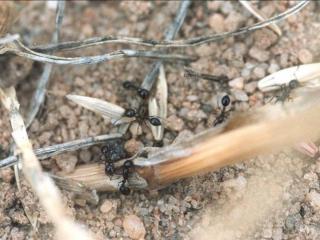Encouraging insect predation of seed
Weed seeds provide a major component of many insect diets this means weed seedbanks can be decreased naturally by encouraging insect (predominantly ant) predation.
Research has found that insect predation of annual ryegrass can significantly reduce seedbank numbers, with removal rates ranging from 0-100% depending on the proximity of the seedbank to ant colonies. Predation by insects was found to be higher for annual ryegrass seed than wild radish seed in a study in the Western Australian wheatbelt. After three months, 81% of the original annual ryegrass seeds had been removed compared to 46% of wild radish.
Maximise insect predation of seed
- Predation levels tend to be higher in situations close to 'refuge' areas (such as remnant vegetation or fence lines) and decreases with increasing distance from the refuge.
- Predation can be maximised by avoiding the overuse of broad spectrum insecticides. Prolonged broad spectrum insecticide use will decrease the number of 'friendly' insects in paddocks.
- Retaining stubble is a double-edged sword. Stubble can provide a refuge for predatory insects, but it also discourages heat-loving ant species which prefer open spaces. Stubble type is also important. Compared to cereal, canola stubble can reduce the numbers of some ant species and consequently the level of wild radish seed pod removal, particularly in early summer.
- Minimum tillage improves predation of weed seeds. Tillage, especially in heavy clay soil types reduces ant populations. It is thought that a cropping system that employs a minimum amount of soil disturbance is optimal. Additionally, soil disturbance during summer reduces seed predation.
More information can be found at GRDC IWM hub: Managing the weed seedbank.

